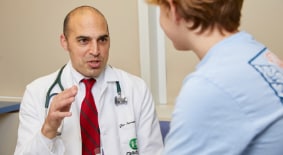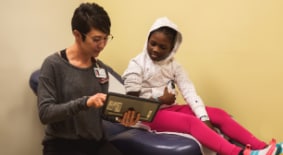Ventricular Septal Defect
What is a Ventricular Septal Defect (VSD)?
A ventricular septal defect (VSD) is a congenital heart defect in which there is an opening or hole in the dividing wall (septum) between the two lower chambers of the heart (right and left ventricles). VSDs are one of the most common types of congenital heart defects.
In normal fetal development, the wall between the chambers closes before the fetus is born so that by birth, oxygen-rich blood is kept from mixing with the oxygen-poor blood. A VSD persists after the child is born when the wall does not fully form.
There are different types of VSDs. The type your child has depends on which part of the wall between the ventricles is involved and the size of the opening or hole.
A Spotlight on Our Pediatric Heart Specialties
How is a VSD diagnosed?
A VSD may be detected by an ultrasound, or fetal echocardiogram, before your child is born. However, it may not be detected until later on.
Your child's healthcare provider may suspect an issue when they hear an abnormal sound, or heart murmur, when listening to your child's heart with a stethoscope. If this happens, your healthcare provider may refer your child to a pediatric cardiologist.
The pediatric cardiologist will check your child and listen to your child's heart and lungs. The details of the murmur will also help the heart doctor make the diagnosis.
One of the best ways to confirm the presence of a VSD is to perform an echocardiogram, or ultrasound of the heart. The echocardiogram, or echo, can determine the size and location of the VSD. The echo can also look for valve leakage, heart enlargement or flow disturbances related to the VSD. An echo may not be needed at each visit since the physician can tell if the VSD is present or closed based on the presence of a heart murmur when listening with a stethoscope.
What are symptoms of a VSD after a baby is born?
The size of the opening or hole in the septum affects how severe your child's symptoms are. Small VSDs do not cause symptoms. The larger the opening, the more blood that passes through it, which causes increased blood volume to return to the left side of the heart.
The age at which your child first has symptoms also affects the severity of symptoms. Your child may have symptoms from birth, or your child may not have symptoms until she is a little older. Symptoms may vary in each child, but they can include:
- Tiredness
- Fast or heavy breathing
- Poor feeding or tiring while feeding
- Long time to finish feeding, requiring multiple breaks
- Poor weight gain
- Rapid heartbeat
- Sweating
Most babies with significant VSDs breathe faster throughout the day and during feeding. These symptoms are often referred to as “heart failure” in infants and babies, but this is different from the heart failure seen in adults. The pumping function of the heart is typically normal in children with VSDs, but the extra flow to the lungs and left side of the heart is what pediatric heart specialists consider heart failure. Do not be alarmed if you see heart failure on your child's diagnosis list if she has a significant VSD. This simply means that the VSD is causing symptoms, and the symptoms usually go away after surgery for significant VSD.
How do you treat a VSD?
Treatment greatly depends on the location of the VSD, the size of the hole and if your child is experiencing symptoms related to the hole.
Some small VSDs may close on their own as your child grows. There are also small defects that may not close on their own but do not require treatment or surgery. These small holes typically only cause a heart murmur but can persist for many years in some children. Fortunately, most small VSDs simply need intermittent monitoring by a cardiologist every few years.
A larger VSD often needs to be fixed with surgery. Once a child is diagnosed with a VSD, the cardiologists will check her regularly to see if the VSD is closing on its own.
- Medicine
- Some children may need to take medicine to help the heart work better. Children without symptoms may not need medicine.
- Adequate nutrition
- Infants with a larger VSD may get tired when feeding. They may not be able to eat enough to gain weight. They may need:
- High-calorie formula or breastmilk. Your child may need nutritional supplements added to her formula or pumped breastmilk. This increases the number of calories in each ounce.
- Supplemental tube feedings. Your child may need to be fed through a small, flexible tube. This tube passes through the nose, down the esophagus and into the stomach. Your child may have tube feedings along with or in place of bottle feedings. Infants who can drink part of their bottles may be fed the rest through a feeding tube. Infants who are too tired to bottle-feed may get all of their nutrition through the feeding tube. Fortunately, feeding substantially improves in most children after surgery, and tube feedings are often discontinued several weeks or months after surgery.
- Infants with a larger VSD may get tired when feeding. They may not be able to eat enough to gain weight. They may need:
- Surgery
- The goal of surgery is to close the hole in the heart to eliminate the extra workload on the heart.
- Surgery will also help infants who have trouble feeding gain a normal amount of weight. Your child's heart doctor at the Children's Heart Center will decide when your child should have heart surgery. This may be based on echocardiogram results and how significant your child's symptoms are. Surgery will be scheduled if there is significant enlargement on the left side of the heart on the echo, since this is a sign that the hole is causing a substantial volume load on the heart.
- In surgery, your child's doctor will close the VSD with stitches or a special patch. Ask your child's heart doctor for more information.
What is the future like for a child born with a VSD?
- Small-sized VSDs
- Infants with small-sized VSDs may have no symptoms. Most children with small VSDs do not require medicine or surgery. Most small VSDs close within the first several years of life. There are some patients for whom the VSD stays open into their teenage years. These children usually grow and develop normally. They also have no activity restrictions and live normal, healthy lives. One exception to small VSDs that don't require surgery is the perimembranous or membranous VSD. Although small in size, these VSDs can cause flow turbulence inside the heart and/or valve leakage due to the location of the hole. As a result of these other changes in the heart, repair surgery may be required. Your child's cardiologist will monitor for these findings at follow-up visits.
- Moderate- to large-sized VSDs
- If the size of the VSD is moderate to large, your child's heart doctor will closely monitor weight gain, feeding and the development of symptoms. The doctor will decide when and how your child's VSD will be fixed. Before surgery, your child may need medicine and special feedings. Your child's healthcare team will give you information and support so you can care for your child at home. Children who need surgery will be admitted to the hospital for surgery.
- Babies who have trouble eating before surgery often have more energy right after surgery. They start to eat better and gain weight faster. The symptoms related to the VSD usually go away entirely after the hole is closed with surgery. The change in your child's status may be dramatic. Most parents note substantial improvement in how they feel about their child's health after surgery.
- After surgery, older children can often be active without getting too tired. Within a few weeks, your child should be fully recovered. Your child should be able to do normal activities. Your child's healthcare team may give you instructions on how to care for your child.
- Most children who have surgery for a VSD will lead normal, healthy lives. Their activity levels, appetite and growth often return to normal. Your child's heart doctor may prescribe antibiotics to prevent infections after leaving the hospital. Children who require surgery for VSDs often do not have any restrictions for sports or school. Your child will need to see a cardiologist every couple of years despite the hole being closed, since scar tissue can form near the region of the VSD and may cause flow obstruction. The cardiologist will monitor your child's heart rhythm and the area of the hole that was repaired at these follow-up visits for years after surgery.
- Ask your child's healthcare provider about your child's outlook. When this condition is diagnosed early, the outcome is often excellent. When a VSD is diagnosed later in life, if complications occur after surgery, or if the VSD isn't repaired, the outlook may be poor. There is a risk of complications from a VSD. Children at risk for these problems should have follow-up care at a center that specializes in congenital heart disease.
Advancements and Innovation in Pediatric Heart Care
Meet Our Cardiothoracic Surgery Team
At Children's, our cardiothoracic surgery team is dedicated to the well-being and care of children of all ages—from birth to 21—who have been diagnosed with a congenital heart defect.
- Paul Chai, MD, Chief of Cardiothoracic Surgery and Co-Chief of the Children's Heart Center
- Joshua Rosenblum, MD, PhD
- Subhadra Shashidharan, MD
- Fawwaz Shaw, MD
- Mohan John, MD
- Kimberly Woodall, CPNP
- Melanie McBrayer, CPNP
Resources for Heart Families
Contact Us 404-256-2593








